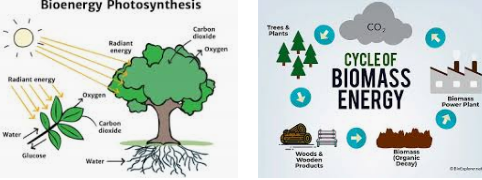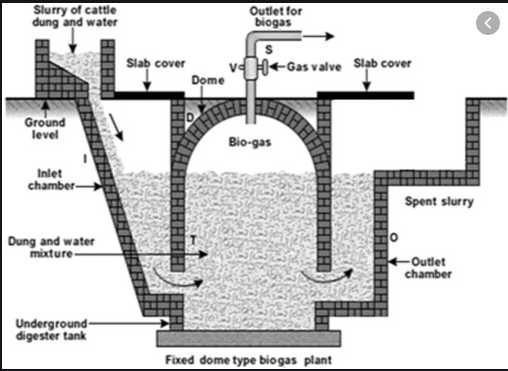 |
| Biomass energy |
Biomass :
The dead parts of plants and trees, and the waste material of animals are called biomass. All the plants and trees which provide biomass (like wood) used sun's energy to grow.
biomass is a renewable source of energy because it is obtained from plants (or animals) which can be produced again and again.
For Example: wood, charcoal, cow dung , biogas etc
Wood :
Wood is biomass. When wood is burnt, heat is produced.
Wood is a renewable source of energy. Wood is obtained by cutting down the trees.
The traditional use of wood as a fuel has many disadvantages.
(i) the burning of wood produces a lot of smoke which pollutes the air,
(ii) the calorific value of wood is low, being only 17 kJ/g, This means that wood produces less heat per unit mass, on burning.
Charcoal:
Charcoal can be prepared from wood as follows :
When wood is burnt in a limited supply of air, then water and other volatile materials present in it get removed and a black substance 'charcoal' is left behind. Charcoal is mainly carbon (C). Charcoal is mainly used as a fuel for domestic purposes. Charcoal is a better fuel than wood because of the following reasons :
(i) Charcoal has a higher calorific value than wood. That is, charcoal produces more heat on burning than an equal mass of wood.
Calorific value of charcoal is higher, being about 33 kilojoules per gram, that of wood is low, being only 17 kilojoules per gram.
(ii) Charcoal does not produce smoke while burning whereas wood produces a lot of smoke on burning and pollutes the air.
(iii) Charcoal is a compact fuel which is easy to handle and convenient
Cow-Dung
Cow-dung is biomass. Cow-dung is the 'excreta' of cattle such as cows and buffaloes, etc. Cow-dung is usually semi-solid. In villages, dried cow- dung cakes have been traditionally used as a fuel for cooking food. When cow-dung cakes are burnt, they produce heat.
It is not good to burn cow-dung directly as a fuel because of the following disadvantages :
(i) Cow-dung contains important elements like nitrogen and phosphorus (called nutrients), which are required by the soil support crops. So, burning of dung in the form of dung cakes destroys the useful nutrients which can otherwise be used as a manure in agriculture.
(ii) Dung cakes produce a lot of smoke on burning which causes air pollution.
(iii) Dung cakes do not burn completely, they produce a lot of ash as residue.
(iv) Dung cakes have low calorific value.
Anaerobic degradation
The decomposition which takes place in the absence of oxygen is called anaerobic degradation. Anaerobic degradation is carried out by the micro-organisms called anaerobic bacteria.
Biogas:
Biogas is a mixture of methane, carbon dioxide, hydrogen and hydrogen sulphide. The major constituent of biogas is methane, which is an extremely good fuel.
biogas contains up to 75 per cent of methane gas which makes it an excellent fuel.
Biogas is produced by the anaerobic degradation of animal wastes like cow-dung . This degradation is carried out by anaerobic bacteria in the presence of water but in the absence of oxygen.
In extraction of biogas, Only the organic matter of cow dung is decomposed and converted into biogas. The other elements like nitrogen and phosphorus, etc., remain intact. In this way, the nutrients like nitrogen and phosphorus can be returned to the soil in the form of manure.
When used in this way, cow- dung gives us a double advantage :
(i) it gives us a clean fuel called biogas
(ii) the spent dung can be used as a manure.
Biogas Plant
A biogas plant consists of a well-shaped, underground tank T called digester, and has a dome-shaped roof D which are made of bricks.
The digester is a kind of sealed tank in which there is no air (or oxygen). The dome of the digester tank acts as a gas-holder or storage tank for the biogas.
There is a gas outlet S at the top of the dome having a valve V. On the left side of the digester tank is a sloping inlet chamber I and on the right side is a rectangular outlet chamber O, both made of bricks.
The inlet chamber is for introducing fresh dung slurry into the main digester tank whereas the outlet chamber is for taking out the spent dung slurry after the extraction of biogas.
The inlet chamber is connected to a mixing tank M while the outlet chamber is connected to the overflow tank F.
Working of a biogas plant.
 |
| Biogas plant |
Cow-dung and water are mixed in equal proportions in the mixing tank M to prepare the slurry. This slurry of dung and water is fed into the digester tank T through the inlet chamber I. The digester tank is filled with dung slurry upto the cylindrical level .the dome being left free for the collection of biogas.
It takes about 50 to 60 days for the new gas-plant to become operative (start functioning). During this period, the cow-dung undergoes degradation by anaerobic bacteria in the presence of water (but absence of oxygen) with the gradual evolution of biogas.
This biogas starts collecting in the dome. As more and more biogas collects in the dome, it exerts pressure on the slurry in the digester tank, and forces the spent slurry to go into overflow tank F ,through the outlet chamber O.
From the overflow tank, the spent slurry is removed gradually. The spent dung-slurry, left after the extraction of biogas, is rich in nitrogen and phosphorus compounds and hence forms a good manure.
Once the gas-plant becomes operative, more fresh dung slurry is added to the digester 'tank regularly and this leads to the continuous biogas production.
The biogas which has collected in the dome of the digester tank is taken out through the outlet S and supplied to village homes through a network of pipes to be used as a cooking gas.
Uses of biogas:
1. Biogas is used as a fuel for cooking food. When biogas is burned in a gas stove, it produces a lot of heat. This heat is used for cooking food and for other heating purposes. Biogas is a good domestic fuel because of the following reasons :
(a) Biogas burns without smoke and hence does not cause air pollution.
(b) Biogas has a high calorific value. That is, biogas produces a large amount of heat per unit mass.
(c) Biogas burns completely without leaving behind any residue
(d) There is no storage problem for biogas as it is supplied by pipes directly from the gas plant.
(e) Biogas is cheaper than most common fuels.
2. Biogas is also used for lighting.
3. Biogas is used as a fuel to run engines. At many places, the engines of water pumping sets used for irrigation are run on biogas, instead of diesel.
4. Biogas is used for generating electricity. Biogas is a renewable source of energy.


No comments:
Post a Comment